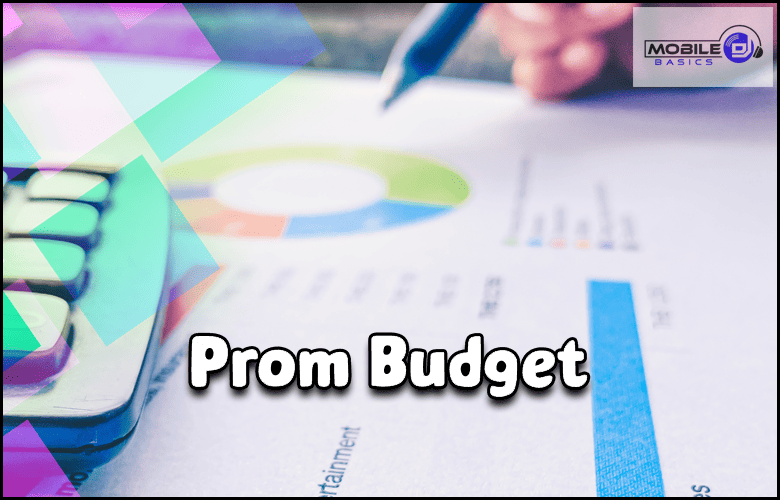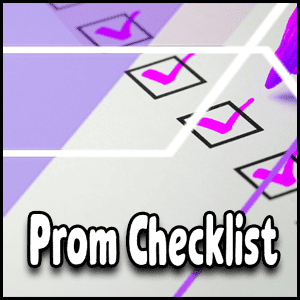
Prom night is a defining event for high schoolers. It’s an opportunity to dress up, feel glamorous, and immerse oneself in the magic of a well-chosen Prom theme, all while forgetting the daily stresses of life for one unforgettable night – but it can also be expensive.
If you’re part of the prom planning committee, understanding how to budget for your school’s dance could mean the difference between having an extraordinary evening or seeing all of your hard work go down in flames due to costly mistakes.
Here’s our guide on creating a successful prom budget that will keep everyone happy and let you get back to enjoying the most memorable day of Senior Year!
Prom Budget
Creating a prom budget requires considering all potential expenses. Here are the major items that should be included:
- Venue: This includes the cost of renting the space, and could also involve insurance or cleaning fees.
- Decorations: This includes all elements related to the theme, like centerpieces, banners, balloons, table linens, props, and a backdrop for photos.
- Catering: This includes the cost per person for food and drink. Don’t forget to budget for dietary alternatives for those with food restrictions.
- Entertainment: This includes the cost of hiring a DJ or band. You may also want to include costs for additional entertainment like a photo booth or hired performers.
- Security: Depending on the size and location of your event, you might need to hire security personnel.
- Invitations and Tickets: The cost of designing, printing, and possibly mailing invitations and tickets.
- Photographer/Videographer: If you plan on hiring a professional photographer or videographer, include their fees in the budget.
- Favors: If you’re providing prom favors or goody bags, include the cost of these items.
- Transportation: If the prom is far from the school, you might need to organize transportation, like hiring a bus or coach service.
- Additional Equipment: This might include a sound system, lighting equipment, a dance floor, or a stage, unless these are provided by the venue or DJ.
- Event Insurance: Depending on the nature of your event and the requirements of your venue, you might need event insurance.
- Miscellaneous: It’s a good idea to set aside some funds for unexpected costs or last-minute additions.
Remember that your budget will need to be adjusted based on your particular circumstances, including the funds available, the size of your event, and the expectations of your student body.
It’s a good idea to overestimate costs slightly to ensure you have a buffer in case things turn out to be more expensive than planned.
Prom Budget Breakdown: Allocating Expenses
Creating a prom budget requires considering all potential expenses.
Here are the major items that should be included, with an approximate percentage of the total budget each item may represent.
Remember that these are just averages and your costs may vary depending on your specific situation.
- Venue (20-30%): This includes the cost of renting the space, and could also involve insurance or cleaning fees.
- Decorations (10-15%): This includes all elements related to the theme, like centerpieces, banners, balloons, table linens, props, and a backdrop for photos.
- Catering (25-35%): This includes the cost per person for food and drink. Don’t forget to budget for dietary alternatives for those with food restrictions.
- Entertainment (10-20%): This includes the cost of hiring a DJ or band. You may also want to include costs for additional entertainment like a photo booth or hired performers.
- Security (5-10%): Depending on the size and location of your event, you might need to hire security personnel.
- Invitations and Tickets (2-5%): The cost of designing, printing, and possibly mailing invitations and tickets.
- Photographer/Videographer (5-10%): If you plan on hiring a professional photographer or videographer, include their fees in the budget.
- Favors (2-5%): If you’re providing prom favors or goody bags, include the cost of these items.
- Transportation (5-10%): If the prom is far from the school, you might need to organize transportation, like hiring a bus or coach service.
- Additional Equipment (5-10%): This might include a sound system, lighting equipment, a dance floor, or a stage, unless these are provided by the venue or DJ.
- Event Insurance (1-3%): Depending on the nature of your event and the requirements of your venue, you might need event insurance.
- Miscellaneous (5-10%): It’s a good idea to set aside some funds for unexpected costs or last-minute additions.
These percentages are estimates and the actual costs can vary widely based on location, the specific choices you make, and how much you’re able to negotiate with vendors.
The important thing is to keep track of all your expenses and make sure they stay within your overall budget.
FAQ
1. Q: How do we establish a prom budget?
A: Start by estimating the total cost of the prom, including venue, catering, entertainment, decorations, and other expenses. Then, consider how much you can raise through ticket sales, fundraising, and any school contributions.
2. Q: How should we price our prom tickets?
A: Your ticket price should cover the cost of the event. Divide your total budget by the estimated number of attendees to get a starting point, then adjust as necessary based on what your attendees can afford.
3. Q: What if our costs exceed our budget?
A: If costs exceed your budget, you’ll need to make some tough decisions. Can you cut back on certain expenses, increase ticket prices, or find additional funding? Be prepared to negotiate with vendors and to prioritize spending based on what’s most important.
4. Q: Should we plan for unexpected costs in our budget?
A: Definitely. It’s always a good idea to reserve a portion of your budget (around 5-10%) for unexpected expenses that might arise during the planning process.
5. Q: How can we cut costs without compromising the quality of the prom?
A: Consider DIY decorations, using a student committee for certain tasks instead of hiring professionals, and negotiating with vendors. You can also save by choosing a less expensive venue or caterer, or by simplifying the menu.
6. Q: How much should we spend on security for our prom?
A: Security is important, but costs can vary widely based on the size and location of your event, and the local rates for security personnel. As a rough estimate, aim to allocate around 5-10% of your budget for security.
7. Q: How can we track our expenses and stay on budget?
A: Use a spreadsheet or budgeting software to track all expenses. Regularly review your budget, update it with actual costs, and adjust future spending as necessary to stay on track.
8. Q: Do we need to include sales tax in our budget?
A: Yes, don’t forget to account for sales tax in your budget. The rate will depend on your local laws. Be sure to ask vendors whether their quoted prices include tax.
Remember, a successful prom doesn’t have to be a costly one. With careful planning and budgeting, you can create a memorable event that stays within your financial limits.
Conclusion
Planning a high school prom on a budget can be challenging, but with the right tips and tricks, it’s totally doable.
Prioritizing your needs, researching vendors beforehand, negotiating prices and working closely with the school administrators and student leadership are all essential steps you’ll need to take if you want to make this event successful.
Prom night has often been touted as one of life’s important milestones – it’s an unforgettable experience that should bring joy and celebration.
With a little bit of strategy and the right mindset, you’ll have no problem keeping on budget when organizing your upcoming high school prom!
At the end of the day, as long as everyone leaves happy and with wonderful memories, that’s all that matters.




